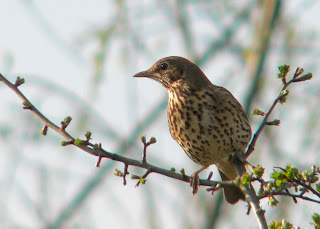 I guess I should explain, since it is still only January. I know technically it isn't spring, but the bird world starts preparing early. Around this time you can expect to hear Great Tits and Song Thrushes (pictured left) calling out, attracting mates and claiming territories. Plumages start to look their best, and the first signs of life can be found on the trees.
I guess I should explain, since it is still only January. I know technically it isn't spring, but the bird world starts preparing early. Around this time you can expect to hear Great Tits and Song Thrushes (pictured left) calling out, attracting mates and claiming territories. Plumages start to look their best, and the first signs of life can be found on the trees.And indeed that is what I found at Leam Valley this morning, combined with plenty of remnants of winter - Siskins and Redpolls in the alder trees, Redwings in the hawthorn scrub and Fieldfares flying over. Among the other nice finds for the morning were three Bullfinch, good views of two Great Spotted Woodpeckers, plenty of Goldcrest, two Jays, three Tufted Ducks on the scrape, and a Mistle Thrush, churring loudly as it flew to a nearby tree.
I enjoyed myself thoroughly, with a grand total for a two hour session of 33 species.
Bird of the Day: Mistle Thrush (Turdus viscivorus), a strong, powerful thrush which I don't see too often 'round here.